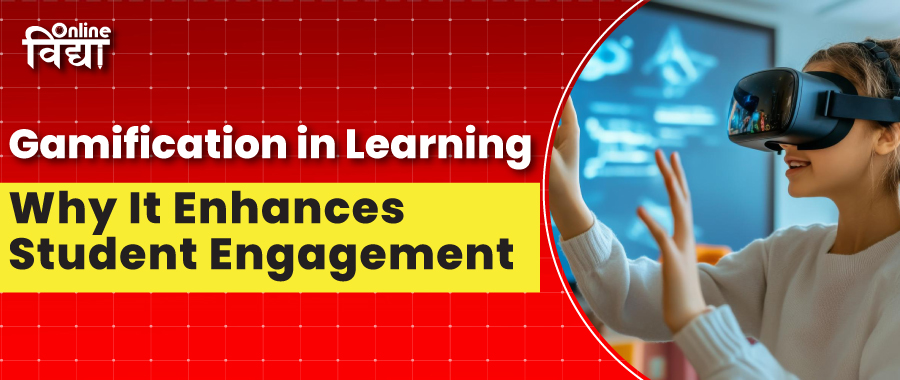Specializations
Courses Available
Courses

Gamification in Learning: Why It Enhances Student Engagement
Gamification in Learning: Why It Enhances Student Engagement,May 22, 2025
Information
May 22, 2025
977 Views
- Share:
Today, learners are digital natives, and thus, they require education that will cater to their needs rather than just their interests. One possible force behind the most successful change on the school front is probably gamification practices. Gamification practices have actually implemented video game mechanics in educational premises to create the most engaging, interactive, stimulating, and entertaining atmosphere in classrooms.
This gamifies certainly not every subject into an online game but applies to setting up a few key elements common in games, like points, levels, leaderboards, and rewards, which motivate the students to learn and participate. And, since right now there are so many students well aware of gaming outside their classrooms, it adds validity and fun to the process of learning.
In this blog, we shall discuss gamification, how it functions in the education sector, its benefits, real-life examples, challenges, and answers to frequently asked questions regarding this new method that is being adopted by many educational institutions today.
What is Gamification?
Gamification is the incorporation of game features into a context. In the classroom, these strategies are making big leaps in terms of improving the learning process, much like video games. The most famous game features, to name a few, are:
- Points: For completing tasks, answering them correctly, or showing improvement.
- Badges: Represent milestones or important learning objectives.
- Leaderboards: Rankings encourage positive competition.
- Levels: Mark your progress and mastery.
Gamification Work with Classes
Gamification can be used at all levels and in all subjects. The following are some applications of gamification:
- Interactive Quiz: Kicking out boring exams for fun, competitive games with Kahoot!, Quizizz, and Socrative.
- Progress Monitoring: Show the students their progress with visual indicators like the amen progress bar.
- Classroom Currency: Rewarding virtual currency or points that they can spend on rewards or privileges.
- Achievement Badges: Granting digital badges for assignment completion or showing acceptable behavior.
- Gamified Learning Platforms: An example of gamification features used to teach languages and academic subjects is Duolingo and Khan Academy.
Benefits of Gamification in Education
1. Higher Student Engagement
Gamification is entertaining. The more the students are engaged, the more they remain focused and participate.
2. Motivation to Learn
Rewards and challenges are game-like features that motivate students to keep on the learning path. Completing quests or accumulating points brings a sense of achievement.
3. Better Retention
With games, one must repeat actions, and this, in turn, reinforces learning. The interactive nature of gamification becomes a memory aid and a comprehension aid.
4. Healthy Competition
Leaderboards and scoreboards encourage good competition. Students are encouraged to perform well, not just for grades, but for glory.
The hurdles of gamification
Despite the myriad of advantages it has to offer, gamification does harbor some challenges:
- Over-competition: Some students do not thrive in competitive environments. Teachers must be responsible for ensuring that competition is made healthy and non-threatening.
- Teacher Training: Training teachers in the use of gamified tools is another challenge that requires some optimization and time.
- Sustainability: It becomes hard to sustain student interest over the long term if the game dynamics grow boring or predictable.
Gamification of education becomes a very powerful tool when harnessed just the right way to enhance the motivation, engagement, and comprehension of both students and teachers. Teachers can now integrate game elements into teaching efforts, making the classroom much more engaging and fun.
With technology being an ever-increasing part of life, gamified education is also likely to follow suit. Though it is not a universal solution, it provides a creative alternative for meeting the needs of the learners of today.
From simple point accumulations to total-theory interactive learning environments, gamification is changing the way students are imparted learning.
FAQs
1. How is game-based learning different from?
Gamification introduces sports elements in traditional learning (such as numbers and brands), while actual games are employed as a learning process in gaming-based learning.
2. Can simplification be used in universities?
Yes, gamefied platforms and systems are used by universities to increase online lecture and course participation.
3. Is gamification for each subject?
Absolutely. Despite mathematics and language -popular topics, gamification can be configured for history, science, art, and many others.
4. Do students learn more effectively with gamification?
Many studies indicate that students are busier and remember more when gaming is used properly.
5. How can teachers start using gaming in their classes?
Teachers can start small, such as quiz apps (quize, khoot!) Using or noticing for performance. Over time, they can use more sophisticated aspects depending on the student's response.

Meet Our Counselling Experts
Get 100% Free Career Counseling




PlacementPartners










Schedule Your 30 min Couselling Session With Today!!
Select a Date of your choice :
You Have Selected Slot on .

